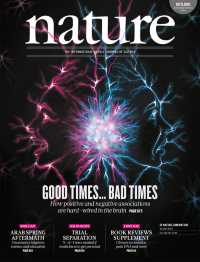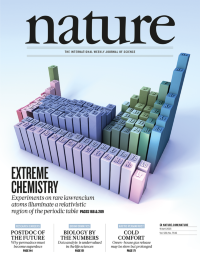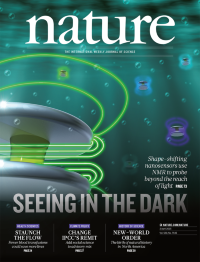Volume 520
-
No. 7549 30 April 2015
The amygdala is part of the brain important for emotional processing, handling stimuli that have either positive or negative associations � the good and the bad. Little is known about how amygdala neurons differentiate or compartmentalize these distinctions. Here, Kay Tye and colleagues identify the basolateral amygdala (BLA) as a site of divergence for circuits mediating positive and negative emotional or motivational responses. In studies in mice they find that neurons in the BLA projecting to fear or reward circuits undergo opposing changes in synaptic strength following fear or reward conditioning. Selective activation of neural populations causes, respectively, either negative or positive reinforcement. Transcriptome analysis reveals candidate genes that may mediate these functional differences. Cover art: Insil Choi.
Nature Outlook
-
No. 7548 23 April 2015
The first bend of the Yangtze river, in Yunnan Province, China. This dramatic scenery boasts up to 3 km of relief, but also high-elevation, low-relief valleys perched above the gorges of the Yangtze, Mekong and Salween rivers. One of these valleys provided inspiration for the mythical Shangri-La. High elevation, low relief surfaces or relict landscapes� are generally thought to be uplifted, old landscapes that preserve past tectonic and environmental conditions. Rong Yang et al. have tested current models of landscape evolution using digital topographic analysis of so-called relict landscapes in southeast Tibet and Yunnan province. They find that the high valleys may not be old passively uplifted surfaces. Rather, these landscapes form in situ as a result of river drainage reorganization that renders some rivers starved of water and thus unable to balance tectonic uplift. Cover: Sino Images/Getty
-
No. 7547 16 April 2015
Cultured cell lines, including many cancer cell lines, are essential tools not only in biological research but also other areas of science. Unfortunately, it has been long known that many cell lines are contaminated, mislabelled or incorrectly annotated. Richard Neve and colleagues now present an analysis providing unambiguous authentication and annotation for more than 3,500 cell lines. This resource offers a reference point for both short tandem repeats (STR) and single nucleotide polymorphism (SNP) profiles as genetic methods of cell annotation, combined with suggested standards for nomenclature using a controlled vocabulary. In a parallel development, we present on page 307 a new publication policy designed to increase the scrutiny around cell line identity problems. Cover: AXS Biomedical Animation Studio
-
No. 7546 9 April 2015
The most dramatic modern revision of Mendeleevs periodic table of elements came in 1944 when Glenn T. Seaborg placed a new series of elements, the actinides (atomic numbers 89�103), below the lanthanides. In this issue of Nature, Yuichiro Nagame and colleagues report the first measurement of one of the basic atomic properties of element 103 (lawrencium), namely its first ionization potential. Lawrencium is only accessible via atom-at-a-time synthesis in heavy-ion accelerators, so experimental investigations of its properties are rare. Nagame and colleagues were able to reduce the number of atoms required to measure the ionization potential from billions to thousands, and these results � in agreement with the latest theoretical calculations � show that the last valence electron in lawrencium is the most weakly bound one in all actinides and any other element beyond group 1 of the periodic table. This signature � in a region of the periodic table where the sheer size of the atoms means that relativistic effects play a crucial role � confirms the end of the actinide series at element 103. Cover: Nik Spencer/Nature.
-
No. 7545 2 April 2015
A representation of NMR-readable nanosensors, each consisting of pairs of magnetic disks sandwiching a swellable hydrogel. The fluorescent and plasmonic probes that have been so successful in the life sciences function poorly in locations where light does not penetrate, such as through many biological tissues. Gary Zabow et al. have developed alternative biocompatible probes that could function as radio-frequency analogues to optically based fluorescent and plasmonic sensors. These sensors are magnetic nanoassemblies, detectable down to femtomolar levels, that rapidly change shape in response to stimuli, such as a change in pH in their local environment. Shape changes translate into NMR spectral shifts with potential sensitivities approaching a million times greater than those of traditional magnetic resonance spectroscopies. Cover image: G Zabow





